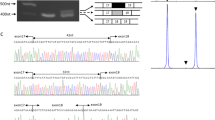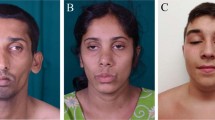Abstract
Thomsen's disease (autosomal dominant myotonia congenita) has recently been linked to chromosome 7q35 in the region of the human skeletal muscle chloride channel gene (HUMCLC). Single strand conformation polymorphism analysis (SSCP) was used to screen DNA from members of four unrelated pedigrees with this disorder for mutations in HUMCLC. Abnormal bands were detected in all affected, but no unaffected individuals in three of the families. Direct sequencing revealed a G to A transition that results in the substitution of a glutamic acid for a glycine residue located between the third and fourth predicted membrane spanning segments. This glycine residue is conserved in all known members of this class of chloride channel proteins. These findings establish HUMCLC as the Thomsen's disease gene.
This is a preview of subscription content, access via your institution
Access options
Subscribe to this journal
Receive 12 print issues and online access
$209.00 per year
only $17.42 per issue
Buy this article
- Purchase on Springer Link
- Instant access to full article PDF
Prices may be subject to local taxes which are calculated during checkout
Similar content being viewed by others
References
Thomson, J. Tonische Krämpfe in willkürlich beweglichen Muskeln in Folge von ererbter psychischer Disposition. Arch. Psychiat. Nervenkr. 6, 702–718 (1876).
Streib, E.W. Differential diagnosis of myotonic syndromes. Muscle Nerve 10, 603–615 (1987).
Becker, P.E. Syndromes associated with myotonia: Clinical-genetic classification. In Pathogenesis of Human Muscular Dystrophies (ed. Rowland, L.P.) 699–714 (Exerpta Medica, Amsterdam, 1977).
Bryant, S.H. The physiological basis of myotonia. In Pathogenesis of Human Muscular Dystrophies (ed. Rowland, L.P.) 715–728 (Exerpta Medica, Amsterdam, 1977).
Bryant, S.H. Myotonia in the goat. Ann. N. Y. Acad. Sci. 317, 314–325 (1979).
Mehrke, G., Brinkmeier, H. & Jockusch, H. The myotonic mouse mutant ADR: Electrophysiology of the muscle fiber. Muscle Nerve 11, 440–446 (1988).
Bretag, A.H. Mathematical modelling of the myotonic action potential. In New Developments in Electromyography and Clinical Electrophysiology (ed. Desmedt, J.E.) 464–482 (S. Karger, Basel, 1973).
Barchi, R.L. Myotonia An evaluation of the chloride hypothesis. Arch. Neurol. 32, 175–180 (1975).
Bryant, S.H. & Morales-Aguilera, A. Chloride conductance in normal and myotonic muscle fibres and the action of monocarboxylic aromatic acids. J. Physiol. 219, 361–383 (1971).
Palade, P.T. & Barchi, R.L. On the inhibition of muscle membrane chloride conductance by aromatic carboxylic acids. J. gen Physiol. 69, 879–896 (1977).
Furman, R.E. & Barchi, R.L. The pathophysiology of myotonia produced by aromatic carboxylic acids. Ann. Neurol. 4, 357–365 (1978).
Lipicky, R.J. & Bryant, S.H. A biophysical study of the human myotonias. In New Developments in Electromyography and Clinical Neurophysiology (ed. Desmedt, J.E.) 451–463 (S. Karger, Basel 1973).
Lipicky, R.J. Myotonic syndromes other than myotonic dystrophy. In Handbook of Clinical Neurology, (ed. Vinken, P.J. and Bruyn, G.W.) 533–571 (North-Holland Publishing Co., Amsterdam, 1979).
Franke, C. et al. Altered Na+ channel activity and reduced Cl− conductance cause hyperexcitability in recessive generalized myotonia (Becker). Muscle Nerve 14, 762–770 (1991).
Iaizzo, P.A., et al. Altered sodium channel behaviour causes myotonia in dominantly inherited myotonia congenita. Neuromusc. Dis. 1, 47–53 (1991).
Jentsch, T.J., Steinmeyer, K. & Schwarz, G. Primary structure of Torpedo marmorata chloride channel isolated by expression cloning in Xenopus oocytes. Nature 348, 510–514 (1990).
Steinmeyer, K., Ortland, C. & Jentsch, T.J. Primary structure and functional expression of a developmentally regulated skeletal muscle chloride channel. Nature 354, 301–304 (1991).
Steinmeyer, K. et al. Inactivation of muscle chloride channel by transposon insertion in myotonic mice. Nature 354, 304–308 (1991).
Koch, M.C. et al. The skeletal muscle chloride channel in dominant and recessive human myotonia. Science 257, 797–800 (1992).
Abdalla, J.A. et al. Linkage of Thorpsen's disease to the TCRB locus on chromosome 7q35. Am. J. hum. Genet. 51, 579–584 (1992).
Orita, M., Iwahana, H., Kanazawa, H., Hayashi, K. & Sekiya, T. Detection of polymorphisms of human DNA by gel electrophoresis as single-strand conformation polymorphisms. Proc. natn. Acad. Sci. U.S.A. 86, 2766–2770 (1989).
Palade, P.T. & Barchi, R.L. Characteristics of the chloride conductance in muscle fibers of the rat diaphragm. J. gen. Physiol. 69, 325–342 (1977).
Adrian, R.H. & Bryant, S.H. On the repetitive discharge in myotonic muscle fibres. J. Physiol. 240, 505–515 (1974).
Rudel, R. & Lehmann-Horn, F. Membrane changes in cells from myotonia patients. Physiol. Rev. 65, 310–356 (1985).
Becker, P.E. Heterozygote manifestation in recessive generalized myotonia. Hum. Genet. 46, 325–329 (1979).
Heinemann, S.H. et al. Calcium channel characteristics conferred on the sodium channel by single mutations. Nature 356, 441–443 (1992).
MacKinnon, R. & Yellen, G. Mutations affecting TEA blockade and ion permeation in voltage-activated K+ channels. Science 250, 276–279 (1990).
Barchi, R.L. A mechanistic approach to the myotonic syndromes. Muscle Nerve 5, S60–S63 (1982).
Ptacek, L.J. et al. Identification of a mutation in the gene causing hyperkalemic periodic paralysis. Cell 67, 1021–1027 (1991).
Rojas, C.V. et al. A Met-to-Val mutation in the skeletal muscle Na+ channel α- subuntt in hyperkalemic periodic paralysis. Nature 354, 387–389 (1991).
McClatphey, A.I. et al. Temperature-sensitive mutations in the III-IV cytoplasmic loop region of the skeletal muscle sodium channel gene in paramyotonia congenita. Cell 68, 769–774 (1992).
Ptacek, L.J. et al. Mutations in an S4 segment of the adult skeletal muscle sodium channel gene cause paramyotonia congenita. Neuron 8, 891–897 (1992).
Byers, P.H., Wallis, G.A. & Willing, M.C. Osteogensis imperfecta: translation of mutation to phenotype. J. med. Genet. 28, 433–442 (1991).
Rosenfeld, P.J. et al. Nature Genet. 1, 209–213 (1992).
Vogelstein, B. & Gillespie, D. Preparative and analytical purification of DNA from agarose. Proc. natn. Acad Sci U.S.A. 76, 615–619 (1979).
Benton, W.D. & Davis, R.W. Screening lambda-gt recombinant clones by hybridization to single plaques in situ. Science 196, 180–182 (1977).
Sambrook, J., Fritsch, E. & Maniatis, T. Molecular cloning: a laboratory manual 2nd edn (Cold Spring Harbor, New York, 1989).
Ott, J. Analysis of human genetic linkage, (Johns Hopkins University Press, Baltimore, 1985).
Author information
Authors and Affiliations
Rights and permissions
About this article
Cite this article
George, A., Crackower, M., Abdalla, J. et al. Molecular basis of Thomsen's disease (autosomal dominant myotonia congenita). Nat Genet 3, 305–310 (1993). https://doi.org/10.1038/ng0493-305
Received:
Accepted:
Issue Date:
DOI: https://doi.org/10.1038/ng0493-305
This article is cited by
-
Skeletal muscle ClC-1 chloride channels in health and diseases
Pflügers Archiv - European Journal of Physiology (2020)
-
Skeletal Muscle Channelopathies
Neurotherapeutics (2018)
-
Clinical, Molecular, and Functional Characterization of CLCN1 Mutations in Three Families with Recessive Myotonia Congenita
NeuroMolecular Medicine (2015)
-
Mutational Consequences of Aberrant Ion Channels in Neurological Disorders
The Journal of Membrane Biology (2014)
-
Recessive congenital myotonia resulting from maternal isodisomy of chromosome 7: a case report
Cases Journal (2009)



